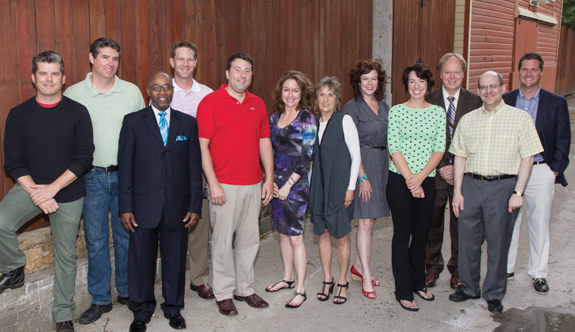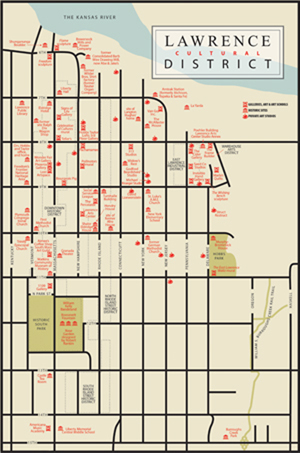| 2013 Summer | story by DAISY WAKEFIELD | photos by STEVEN HERTZOG |

At the third meeting of the Cultural District Task Force, a group of artists, art advocates, downtown business leaders, city leaders, and East Lawrence residents sat around a table casting a vision.
It was a brainstorm of ideas that orbited the recently city appointed Cultural District, an area rich with artistic, historical, political, and cultural buildings, businesses, and landmarks that encompasses much of downtown and East Lawrence. Some ideas were pragmatic: installing proper lighting, making roads walkable or bike-able, coordinating public transport. Other ideas dealt with branding: defining a narrative, engaging stakeholders, avoiding “Disney-fying” the area. Complications (securing funding, ensuring sustainability, addressing neighborhood gentrification) were also discussed.
And of course there were ideas about making art and growing culture. But the Cultural District is more about making use and highlighting what is already existing, rather than creating new things. In the nine by nine block bordered by the Kansas River to the north, Kentucky Street on the west, the Boroughs Creek Trail on the east, and 15th Street on the South, there are approximately 80 historic sites, galleries, studios or art schools. The hope of the task force is to create practical and story-telling pathways between the sites.
“We are taking existing elements in the district and refining and redesigning them to produce an unique end product.” Bob Schumm, chairman of the task force, says. “We are not bringing in stuff from outside, but redefining the use of what’s already there.”
The creation of a cultural district compliments a National Endowment of the Arts initiative called creative placemaking, in which “partners from public, private, non-profit, and community sectors strategically shape the physical and social character of a neighborhood, town, city, or region around arts and cultural activities.” (Creative Placemaking Executive Summary, 2010)
 “In creative placemaking, we capitalize on what make a place, or a district, a neighborhood unique,” says Susan Tate, Director the Lawrence Arts Center and key proponent of the designation of the Cultural District. “Part of our vision is not to change what is there but to connect what’s there through pathways and narrative and branding. What we look for is cross sector support, shared language between non profits, artists, the public, business leaders, chamber of commerce, and elected officials. We see the presence of robust cultural arts district as a plus to our entire community and region. It improves livability, reputation, and in this case tells a story about Lawrence that currently exists.”
“In creative placemaking, we capitalize on what make a place, or a district, a neighborhood unique,” says Susan Tate, Director the Lawrence Arts Center and key proponent of the designation of the Cultural District. “Part of our vision is not to change what is there but to connect what’s there through pathways and narrative and branding. What we look for is cross sector support, shared language between non profits, artists, the public, business leaders, chamber of commerce, and elected officials. We see the presence of robust cultural arts district as a plus to our entire community and region. It improves livability, reputation, and in this case tells a story about Lawrence that currently exists.”
“It is vital that Lawrence look to what is indigenous as a resource for attracting high tech and knowledge-based jobs,” Tate says. “This is an area where Lawrence is struggling even though it should be a strength. If we can tell the story of what’s happening here for creative based people, we can create a narrative for high tech knowledge-based corporations, and they will be attracted here.”
That cross sector support is critical to the eventual success of Cultural District. Fears have been voiced, particularly from East Lawrence artists and residents, about possible gentrification of neighborhoods, driving up space rentals and pushing out the lower socioeconomic sector of that community. The task force is looking to address this concern, asking representatives from the East Lawrence Neighborhood Association to join in the conversation and planning public forums in the future after recommendations have been made.
The creation of the Cultural District was a development intended to bolster the application of a grant made jointly by the city and the Lawrence Arts Center to ArtPlace, a collaboration of 13 national and regional foundations and six of the nation’s largest banks. Lawrence was in the top 100 of 3000 grant applicants, but did not make the final cut. City and Lawrence Arts Center leaders hope another year’s cultivation of the Cultural District will put Lawrence in a much stronger position to win a grant, which ranges from $150K to $500K. The Lawrence Arts Center is still in the running for a $75K Kansas Creative Arts Industries Commission grant.
Other funding possibilities for the maintenance of the Cultural District will be suggested with the task force’s recommendations in October. The city will likely be called on to provide funding for improvements to street infrastructure. Business engagement will also be a key factor in funding, as they can provide reasonable or free space to local artists to showcase their work.
Creating a strong narrative within the Cultural District has several potential economic development benefits, the most basic layer being additional tourism dollars. But Tate says that the benefits of developing a “creative economy” can go much deeper, with money generated through creative-based work industries. She suggests that other cities that have developed successful cultural districts have seen their overall economies boosted. ■

64 Comments
ed meds on line cheap ed pills best online ed meds
Medications online Australia: Buy medicine online Australia – Pharm Au 24
get antibiotics without seeing a doctor buy antibiotics online uk Over the counter antibiotics for infection
online pharmacy australia: Online medication store Australia – Online drugstore Australia
Buy medicine online Australia Pharm Au 24 Pharm Au 24
buy antibiotics from canada buy antibiotics for uti over the counter antibiotics
buy antibiotics: buy antibiotics online uk – buy antibiotics over the counter
kamagra pas cher Pharmacie Internationale en ligne acheter kamagra site fiable
prix bas Viagra generique: livraison rapide Viagra en France – Meilleur Viagra sans ordonnance 24h
commander Viagra discretement: viagra en ligne – livraison rapide Viagra en France
kamagra 100mg prix kamagra 100mg prix kamagra gel
pharmacie en ligne: pharmacie internet fiable France – Pharmacie Internationale en ligne
commander Kamagra en ligne achat kamagra Kamagra oral jelly pas cher
Pharmacies en ligne certifiees: commander sans consultation medicale – pharmacie en ligne france livraison belgique
Pharmacie en ligne livraison Europe: kamagra oral jelly – kamagra livraison 24h
Pharmacies en ligne certifiees pharmacie internet fiable France pharmacie en ligne france fiable
acheter Viagra sans ordonnance: viagra sans ordonnance – Acheter du Viagra sans ordonnance
Medicaments en ligne livres en 24h: pharmacie internet fiable France – vente de mГ©dicament en ligne
acheter Kamagra sans ordonnance п»їpharmacie en ligne france acheter kamagra site fiable
Pharmacies en ligne certifiees: pharmacie internet fiable France – pharmacie en ligne sans ordonnance
kamagra livraison 24h: commander Kamagra en ligne – vente de mГ©dicament en ligne
pharmacie en ligne pharmacie en ligne sans prescription pharmacie en ligne france livraison belgique
Viagra generique en pharmacie: viagra sans ordonnance – Viagra generique en pharmacie
Medicaments en ligne livres en 24h pharmacie internet fiable France pharmacie en ligne france pas cher
Acheter du Viagra sans ordonnance: Acheter du Viagra sans ordonnance – Viagra sans ordonnance 24h
Viagra sans ordonnance 24h: viagra en ligne – prix bas Viagra générique
pharmacie en ligne sans prescription pharmacie en ligne pas cher vente de mГ©dicament en ligne
Acheter Cialis 20 mg pas cher: Cialis generique sans ordonnance – traitement ED discret en ligne
pharmacie en ligne sans prescription pharmacie en ligne п»їpharmacie en ligne france
pharmacie internet fiable France: pharmacie internet fiable France – Pharmacie sans ordonnance
Medicaments en ligne livres en 24h: Medicaments en ligne livres en 24h – vente de mГ©dicament en ligne
pharmacie en ligne sans prescription: pharmacie internet fiable France РAchat m̩dicament en ligne fiable
commander Cialis en ligne sans prescription: acheter Cialis sans ordonnance – cialis generique
commander Kamagra en ligne kamagra gel acheter kamagra site fiable
Cialis générique sans ordonnance: commander Cialis en ligne sans prescription – Cialis pas cher livraison rapide
commander Cialis en ligne sans prescription: Cialis generique sans ordonnance – traitement ED discret en ligne
livraison discrete Kamagra: livraison discrete Kamagra – kamagra oral jelly
https://viasansordonnance.com/# prix bas Viagra generique
commander Viagra discretement viagra en ligne livraison rapide Viagra en France
traitement ED discret en ligne: Cialis sans ordonnance 24h – Cialis generique sans ordonnance
traitement ED discret en ligne: Cialis generique sans ordonnance – cialis prix
cialis generique acheter Cialis sans ordonnance Cialis pas cher livraison rapide
https://kampascher.com/# livraison discrete Kamagra
commander sans consultation medicale: acheter medicaments sans ordonnance – pharmacie en ligne sans ordonnance
kamagra livraison 24h achat kamagra kamagra pas cher
kamagra 100mg prix: livraison discrete Kamagra – kamagra en ligne
Pharmacies en ligne certifiees Medicaments en ligne livres en 24h Pharmacie en ligne livraison Europe
https://ciasansordonnance.shop/# traitement ED discret en ligne
pharmacie internet fiable France: commander sans consultation medicale – pharmacie en ligne france pas cher
commander Cialis en ligne sans prescription traitement ED discret en ligne Cialis pas cher livraison rapide
Meilleur Viagra sans ordonnance 24h: viagra sans ordonnance – commander Viagra discretement
acheter Kamagra sans ordonnance kamagra oral jelly kamagra en ligne
Viagra generique en pharmacie: Viagra pas cher paris – viagra en ligne
acheter Kamagra sans ordonnance kamagra gel acheter Kamagra sans ordonnance
https://viasansordonnance.shop/# Meilleur Viagra sans ordonnance 24h
acheter medicaments sans ordonnance: pharmacie en ligne pas cher – Pharmacie en ligne livraison Europe
Kamagra oral jelly pas cher kamagra oral jelly acheter Kamagra sans ordonnance
cialis prix: acheter Cialis sans ordonnance – commander Cialis en ligne sans prescription
acheter Kamagra sans ordonnance acheter kamagra site fiable kamagra en ligne
п»їpharmacie en ligne france: kamagra livraison 24h – commander Kamagra en ligne
https://pharmsansordonnance.shop/# pharmacie en ligne avec ordonnance
pharmacie en ligne avec ordonnance kamagra 100mg prix acheter Kamagra sans ordonnance
cialis sans ordonnance: Pharmacie Internationale en ligne – traitement ED discret en ligne
commander sans consultation medicale Pharmacies en ligne certifiees pharmacie en ligne france fiable